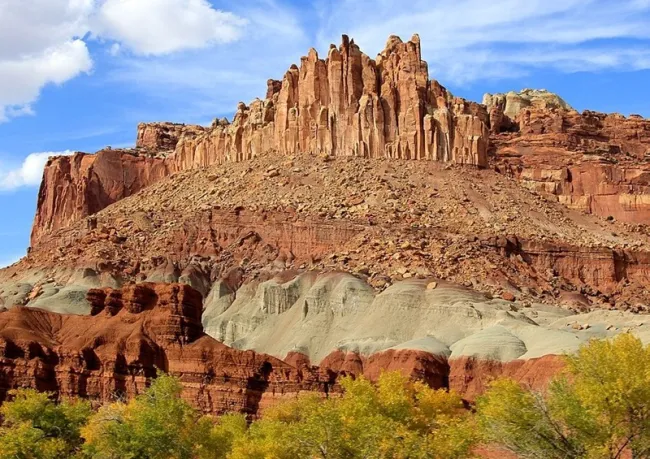
Capitol Reef National Park, located in south-central Utah, is a hidden gem among the state's renowned national parks. Known for its stunning rock formations, including the iconic Waterpocket Fold, Capitol Reef offers a blend of geological wonders, rich history, and serene desert landscapes. The park spans over 241,904 acres and is less visited compared to other Utah parks like Zion and Bryce Canyon, making it a peaceful retreat for nature lovers. Its name comes from the white Navajo Sandstone domes resembling the U.S. Capitol and the rocky "reefs" that were obstacles for early settlers.
History of the Park
Capitol Reef's history is a blend of natural and human stories. The Waterpocket Fold, a 100-mile-long warp in the Earth's crust, was formed between 50 and 70 million years ago. Indigenous peoples, including the Fremont culture, lived in the area thousands of years ago, leaving behind petroglyphs and other artifacts. In the 1800s, Mormon settlers arrived, establishing the small town of Fruita, which became the center of the area’s agricultural history.
The area was first designated as a national monument by President Franklin D. Roosevelt in 1937, and later re-designated as a national park in 1971. The protection of this stunning area allowed for the preservation of its unique geology, historic orchards, and significant archaeological sites.
Main Features
Capitol Reef's main features revolve around its impressive geological formations. The Waterpocket Fold, stretching from Thousand Lake Mountain to Lake Powell, is the park's centerpiece, showcasing steep cliffs, narrow canyons, and beautiful domes. Other highlights include:
- Capitol Dome: Resembling the U.S. Capitol building, this white dome is a defining feature of the park.
- Hickman Bridge: A natural bridge that spans 133 feet across and stands 125 feet tall.
- Cathedral Valley: A remote area with towering monoliths, including the Temple of the Sun and the Temple of the Moon.
- Fruita Orchards: Historic orchards planted by early settlers, still maintained today, where visitors can pick fruit in season.
Types of Trails
Capitol Reef offers a range of trails for all skill levels:
- Easy Trails:
- Grand Wash Trail: A flat trail through a narrow canyon, perfect for an easy stroll.
- Hickman Bridge Trail: A 1.8-mile round-trip hike leading to the stunning natural bridge.
- Moderate Trails:
- Navajo Knobs Trail: A challenging 9.4-mile round-trip hike with panoramic views of the park.
- Cassidy Arch Trail: A 3.4-mile round-trip hike offering breathtaking views and a chance to stand on the arch.
- Strenuous Trails:
- Rim Overlook Trail: A 4.6-mile round-trip trail that provides a strenuous ascent and stunning views of the park below.
For backpackers, the park also offers several multi-day backcountry routes, including access to the rugged and remote Waterpocket Fold.
Crowd Expectations
Capitol Reef is one of the less crowded national parks in Utah, with approximately 1.2 million visitors annually. The park offers a quieter and more intimate experience compared to Zion and Arches. Weekends and holidays can bring more visitors, but overall, the park remains a serene destination. Most crowds gather around the Fruita area, but visitors can easily find solitude in the park's more remote sections, like Cathedral Valley.
Accessibility for Seniors and Wheelchairs
Capitol Reef provides various accessibility features for seniors and visitors with disabilities. The Gifford House, located in the Fruita Historic District, is wheelchair accessible, and parking areas have designated accessible spaces. The visitor center offers an accessible restroom and picnic area. Some shorter, paved paths, like the Goosenecks Overlook, provide opportunities for scenic views without strenuous effort. However, many of the park's trails, due to rugged terrain, are not wheelchair accessible.
Park Amenities
Capitol Reef offers several amenities, including a visitor center with exhibits, maps, and information on the park's history and geology. The Fruita area provides a campground, picnic areas, and historic buildings, including the Gifford House Museum and store. The store sells homemade pies, jams, and other local treats, reflecting the area's agricultural heritage.
Camping Facilities
The Fruita Campground is the main camping facility in Capitol Reef, with 71 sites nestled among fruit orchards. It is open year-round and offers amenities such as picnic tables, fire pits, drinking water, and flush toilets. The sites accommodate both tents and RVs, although there are no hookups available. Reservations are recommended during peak seasons, but sites are available on a first-come, first-served basis in the off-season.
For more adventurous visitors, primitive camping is available at Cathedral Valley and Cedar Mesa, offering a more remote experience with fewer amenities.
Access to Lodging
Lodging options are limited within Capitol Reef itself, but nearby towns like Torrey provide a range of accommodations, from motels to charming bed-and-breakfasts. Staying in Torrey allows easy access to the park while offering comfort and convenience.
Pet-Friendliness
Pets are allowed in Capitol Reef but are restricted to developed areas, including roads and campgrounds. They are not permitted on trails or in the backcountry. Owners must keep their pets on a leash no longer than six feet and clean up after them. The park's policies are designed to protect the park's wildlife and fragile environment.
Best Months to Visit
The best months to visit Capitol Reef are during the spring (April to June) and fall (September to October) when temperatures are mild and comfortable for hiking and outdoor activities. Summers can be hot, with temperatures exceeding 90°F, while winters can be cold, especially at higher elevations. The park’s fruit orchards are in bloom during the spring, making it a particularly scenic time to visit.
Conclusion
Capitol Reef National Park offers a unique blend of geology, history, and tranquility. Its striking landscapes, lesser-known status, and rich heritage make it an ideal destination for those seeking both adventure and solitude. Whether exploring the park’s iconic domes, hiking through its rugged terrain, or simply enjoying the quiet beauty of Fruita’s orchards, Capitol Reef provides an unforgettable experience for visitors of all ages and abilities.



